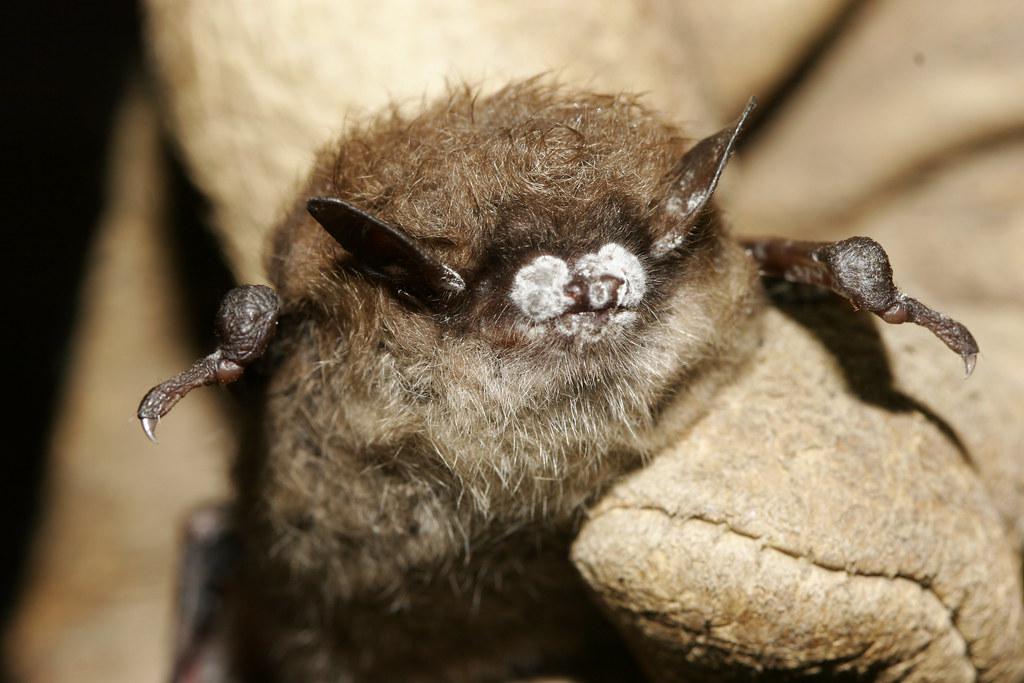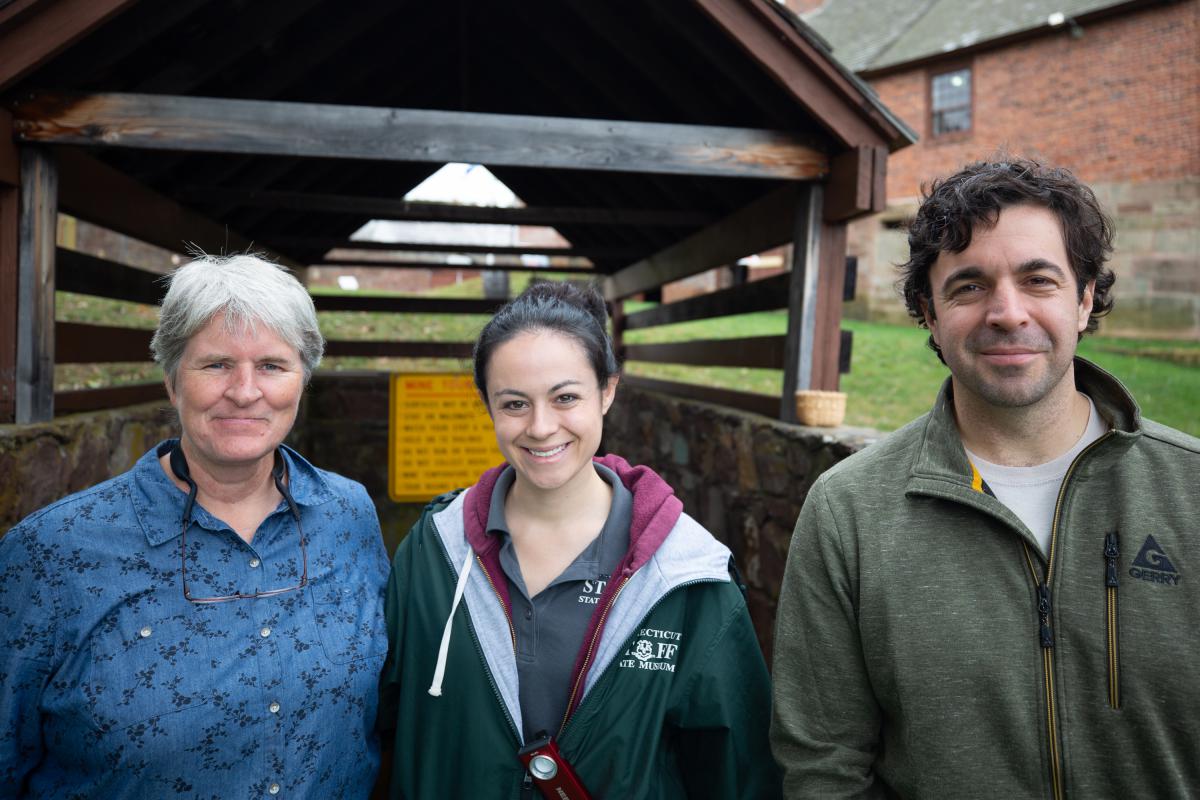Northeastern Bat Populations Haven’t Recovered From White-Nose Syndrome
5:06 minutes

This segment is part of The State of Science, a series featuring science stories from public radio stations across the United States. Original reporting on this story by Patrick Skahill appeared on Connecticut Public Radio.
Morgan Bengel stood about 35 feet underground, gesturing at the cold, rocky walls inside Old New-Gate Prison & Copper Mine. Late 18th-century descriptions of this subterranean penitentiary were bleak.
“Some of the words are, hell, a dungeon, woeful mansion,” Bengel said.
You’d think this would be the perfect place to find bats. It’s a dark damp cave. But during a bat survey here last winter scientists only found 10.
That’s because of white-nose syndrome. A disease caused by a fungus, which flourishes in caves, just like this one. The fungus gets on the muzzle and wings of bats, waking them up from hibernation, and depleting the fat they need to survive the winter.
It’s been more than a decade since the disease was first identified in North America. Since then, white-nose has killed off millions of bats across New England and other parts of the U.S. and Canada.
“We have a site in western Connecticut that was over 3,300 bats that we documented during a winter hibernaculum survey in 2007,” said Kate Moran, a wildlife biologist with the state Department of Energy and Environmental Protection. “We returned there in 2009 and there were more like 300 bats. We returned there in 2010, and we counted fewer than a dozen bats. It was carnage, really.”

White-nose was first documented in New York in the winter of 2006 to 2007. Since then, it’s spread to at least 33 states and 7 Canadian provinces, including all of New England. In Connecticut caves, DEEP biologist Brian Hess said it’s virtually everywhere.
“To our knowledge, all of the caves in Connecticut have the fungal pathogen living in them,” Hess said.
Across Connecticut, the numbers of cave-dwelling bats like the northern long-eared bat, little brown bat, and tri-colored bat all dropped dramatically between 2007 and 2010. Moran said they still haven’t recovered.
“In New England bats were very common. The northern long-eared bat was probably the most common bat we had throughout New England. Now it is the least common bat we have in New England,” Moran said.
And it’s listed as “threatened” under the Federal Endangered Species Act.
Bats are beneficial to people. They eat moths and beetles that can pose dangers to crops. And they also consume mosquitoes, which can spread dangerous diseases like West Nile virus and Eastern equine encephalitis.

Bats also live a long time. Moran said up to 30 years. And bats usually only produce one pup per year, which means any recovery will take a long time.
But it’s not all bad news. Hess said that while white-nose syndrome is present in all of Connecticut’s caves, there are spots within those areas where the fungus doesn’t do as well.
“There are little microclimates within caves that can help bats to survive that fungal load, because the fungus doesn’t grow quite as well if it’s warmer or cooler, or more or less humid than the fungus really, really likes,” Hess said.
What the fungus also doesn’t like, is going outside. It doesn’t survive in UV light or in springtime temperatures, so if a bat can make it through the winter, it can still have a shot at recovery.
That means hope for both the bats and the biologists working to conserve them.

“They’re still here. They haven’t blinked out,” Hess said. “When you have these introductions of diseases or pests, things are dire. But the fact that we still have bats is an encouragement and a reason to keep trying to make sure they still hang around.”
Hess said next year, the plan is to come back to New-Gate, to count bats and try to learn a little bit more about the handful of winter survivors who will awaken from an ecological nightmare.
Invest in quality science journalism by making a donation to Science Friday.
Patrick Skahill is a Science and Environment Reporter at WNPR Connecticut Public Radio in Hartford, Connecticut.
SPEAKER 1: And now it’s time to check in on the state of science.
SPEAKER 2: This is KERA.
SPEAKER 3: For WWNO.
SPEAKER 4: St. Lewis Public Radio.
SPEAKER 5: Iowa Public Radio News.
SPEAKER 1: Local science stories of national significance. Over a decade ago bat populations in the Northeast began to dramatically plummet because of white-nose syndrome. That disease is caused by a flesh-eating fungus that targets bats while they hibernate. To date almost 7 million bats have died from white-nose syndrome, and while government agencies have been working to contain the spread of the fungus the bats continue to die out. And there is new reporting now about how hard the bats have been hit in the state of Connecticut.
Joining me to talk about it and about the state and the bat population is Patrick Scahill, a science environment reporter from WNPR in Hartford. Welcome to Science Friday.
PATRICK SCAHILL: Thanks for having me.
SPEAKER 1: Let’s talk about what is white-nose syndrome. How does the disease kill the bats?
PATRICK SCAHILL: Yeah, so white-nose is a fungal disease that’s really been a dreadful thing for cave dwelling bats in particular, because this is a fungus that does really well in cold, damp places like caves. And as you were saying, Ira, the fungus can get on the wings, the muzzles of the bats, and what it basically does is it wakes them up during hibernation during their over-wintering period, which can deplete their winter energy reserves. They’re kind of, you know, dipping into their gas reserve tank.
And if they wake up too many times they can completely lose those reserves, and that can essentially kill the bat.
SPEAKER 1: Right, and you recently went to a site where bats hibernate in northern Connecticut. What did you see there?
PATRICK SCAHILL: Yeah, so I went to an interesting historical site in Connecticut. Actually Old Newgate Prison & Copper Mine. This was a copper mine that was in operation from 1700, roughly, through the 1750s. It didn’t really do that great. The ore there was kind of bad, so then they said, well, let’s turn it into a prison, because it’s Connecticut and that’s how things were from 1773 until 1827. Now it’s a tourist attraction, and there are a few at bats that live there, but not very many. During the last count there was only 10.
SPEAKER 1: 10? It’s starting out with what? Thousands?
PATRICK SCAHILL: 10. So at this site there was probably a few dozen, but other sites in Connecticut have had thousands. I talked to a biologist, and she had mentioned that there was a site in Western Connecticut where they had documented over 3,300 bats during a winter survey in 2007. Again, this is at around the time white-nose was emerging. They returned there in 2009. The accounts were down to about 300, and when they went back there in 2010 they saw fewer than a dozen bats, and she said this was carnage essentially.
SPEAKER 1: Wow. Is there anything anybody can do to prevent this?
PATRICK SCAHILL: So right now there is no known cure for white-nose syndrome. A lot of scientists are thinking about this. Just this week, actually, the US Fish and Wildlife Service announced $100,000 challenge offering money for two researchers who can potentially identify ways to fight the disease. But right now unfortunately there is no known cure for this.
SPEAKER 1: And what I found interesting about this, and I know you and you know about this, is how it can spread without the bats moving.
PATRICK SCAHILL: Right, so this is actually an interesting point of research for scientists now. So this fungus can spread from bat to bat while they are hibernating, but there are certain areas of the cave where the fungus, you know, the humidity or the temperature isn’t really friendly to the fungus, and the fungus doesn’t do as well. So researchers now are studying those microclimates in the caves to try to determine are there areas where bats can go to maybe fight this disease or avoid this disease.
SPEAKER 1: And why haven’t the populations bounced back at all once you know the vulnerables are gone?
PATRICK SCAHILL: You know, we don’t really know. One of the things I like to say– so in Connecticut we’ve seen sharp declines for many bat species. The little brown bats, tricolored bats. The northern long-eared bat used to actually be New England’s most common bat. Now it’s the least common bat in New England, and it’s actually listed under the US Endangered Species Act. You know, one of the things scientists are looking at now is bats haven’t entirely gone away, right? There are a few that are left. Big brown bats actually have declined in Connecticut, but their numbers are not as bad.
So researchers are trying to study the survivors to see what makes these bats unique, and what makes them special and able to survive this.
SPEAKER 1: And how’d they spread to the West Coast? I mean, the bats can’t fly cross-country. How did they get there?
PATRICK SCAHILL: That is another question that probably points to us, right? So one of the things that happens with white-nose is if you go into a cave and you get the fungus on your shoes, or on your clothes. Potentially you could transport this fungus even maybe across the US, and scientists think this actually is probably what happened in 2016 when the fungus moved all the way across the country and popped up in Washington State there. Bats can’t fly that far, as you said, so that probably was a situation where we did that.
SPEAKER 1: Interesting stuff, Patrick. Thanks for taking time to be with us today.
PATRICK SCAHILL: You’re welcome.
SPEAKER 1: Patrick Scahill is a science and environment reporter from WNPR in Hartford.
Copyright © 2019 Science Friday Initiative. All rights reserved. Science Friday transcripts are produced on a tight deadline by 3Play Media. Fidelity to the original aired/published audio or video file might vary, and text might be updated or amended in the future. For the authoritative record of Science Friday’s programming, please visit the original aired/published recording. For terms of use and more information, visit our policies pages at http://www.sciencefriday.com/about/policies/
Lucy Huang is a freelance radio producer and was Science Friday’s summer 2018 radio intern. When she’s not covering science stories, she’s busy procrasti-baking.
Ira Flatow is the founder and host of Science Friday. His green thumb has revived many an office plant at death’s door.